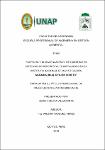| dc.contributor.advisor | Vásquez Pérez, Wilson | |
| dc.contributor.author | Tuesta Villacorta, Isaac | |
| dc.date.accessioned | 2023-08-03T19:15:22Z | |
| dc.date.available | 2023-08-03T19:15:22Z | |
| dc.date.issued | 2013 | |
| dc.identifier.uri | https://hdl.handle.net/20.500.12737/9243 | |
| dc.description.abstract | The purpose of this research was to determine the values of efficient carbon capture and storage in agroforestry systems implemented at INIA (Iquitos-Nauta highway), and to know their sustainable management. The research is descriptive and qualitative, analyzing the characteristics of the carbon sequestration potential of the species within the system. The evaluation of carbon fixation was carried out following the methodology indicated in the Sampling Protocols for Biomass and Carbon in Alternative Projects to slash and burn.
As a final result, when evaluating a hectare of agroforestry systems implemented since 1996-1997, encouraging results of capturing carbon from 16,299 MT/has to 49,964 MT/has are obtained. The plot that obtained the highest carbon capture, species of tornillo, soursop, sangre de grado, caspi lizard are observed where species with DAP greater than 50 cm are observed, as in the case of tornillo (60.0 cm.), lizard caspi (50.0 cm.), soursop (? 80 cm.), sangre de grado (59.0 cm.).
According to bibliographic data, it is reported that an agroforestry plot can produce 24.1 MT/Ha., in 9 years (for 13 years it will be 34.81 MT/ha.) and observing the results obtained, plots 4 to 7 show homogeneity in terms of to the growth of their species because they are close to the established range (they capture carbon in ranges from 35.16 to 49.96 MT/Ha). The continuous growth of the species plus the production of fruit trees and the possible adoption of this technology can generate great economic income. On average, in the lower range, there are 16.22 MT/ha of C, with sales prices: 324.4 dollars/ha. By reforesting quantities of degraded areas and exchanging conservation of resources for carbon credits, necessary profits are obtained to develop other productive projects with a sustainability character, under the premise of conserving production. | en_US |
| dc.description.abstract | La presente investigación tuvo como propósito determinar los valores de la eficiente captura y almacenamiento de carbono en sistemas agroforestales implementados en el INIA (carretera Iquitos-Nauta), y conocer su manejo sostenible. La investigación es descriptiva y cualitativa, analizándose las características del potencial de captura de carbono que tienen las especies dentro del sistema. La evaluación de fijación de carbono se efectuó siguiendo la metodología indicada en los Protocolos de muestreo de Biomasa y Carbono en Proyectos alternativos al corte y quema.
Como resultado final al evaluar una hectárea de sistemas agroforestales implementados desde los años 1996-1997, se obtienen resultados alentadores de capturar carbono desde 16.299 TM/ has., a 49.964 TM/has. La parcela que obtuvo mayor captura de carbono, se observan especies de tornillo, guanábana, sangre de grado, lagarto caspi donde se observa especies con DAP mayores a 50 cm., como en el caso del tornillo (60,0 cm.), lagarto caspi (50,0 cm.), guanábana (? 80 cm.), sangre de grado (59,0 cm.).
Según datos bibliográficos se reporta que una parcela agroforestal puede producir 24,1 TM/Ha., en 9 años (para 13 años será 34,81 TM/ha.) y observando los resultados obtenidos, las parcelas 4 al 7 muestran homogeneidad en cuanto al crecimiento de sus especies porque se acercan al rango establecido (capturan carbono en rangos de 35,16 a 49,96 TM/Ha). El crecimiento continuo de las especies más la producción de frutales y la posible adopción de esta tecnología puede generar grandes ingresos económicos. En promedio en el rango menor se tiene 16,22 TM / ha de C, con los precios de venta: 324,4 dólares/ha. Reforestando cantidades de áreas degradadas y cambiando conservación de recursos por bonos de carbono, se obtuviera ganancias necesarias para desarrollar otros proyectos productivos con carácter de sostenibilidad, bajo la premisa de conservar produciendo. | es_PE |
| dc.format | application/pdf | es_PE |
| dc.language.iso | spa | es_PE |
| dc.publisher | Universidad Nacional de la Amazonía Peruana | es_PE |
| dc.rights | info:eu-repo/semantics/openAccess | * |
| dc.rights.uri | https://creativecommons.org/licenses/by/4.0/ | * |
| dc.subject | Tecnología de producción | es_PE |
| dc.subject | Técnicas | es_PE |
| dc.subject | Carbono orgánico | es_PE |
| dc.subject | Agroforestería | es_PE |
| dc.title | Captura y almacenamiento de carbono en sistemas agroforestales instalados en el Instituto Nacional de Investigación Agraria (INIA). Región Loreto | es_PE |
| dc.type | info:eu-repo/semantics/bachelorThesis | es_PE |
| thesis.degree.discipline | Ingeniería en Gestión Ambiental | es_PE |
| thesis.degree.grantor | Universidad Nacional de la Amazonía Peruana. Facultad de Agronomía | es_PE |
| thesis.degree.name | Ingeniero(a) en Gestión Ambiental | es_PE |
| dc.subject.ocde | https://purl.org/pe-repo/ocde/ford#1.05.08 | es_PE |
| renati.author.dni | 44410517 | |
| renati.advisor.orcid | https://orcid.org/0000-0002-2848-6597 | |
| renati.advisor.dni | 05231969 | |
| renati.type | https://purl.org/pe-repo/renati/type#tesis | es_PE |
| renati.discipline | 521236 | es_PE |
| renati.level | https://purl.org/pe-repo/renati/level#tituloProfesional | es_PE |
| renati.juror | Flores Malaverry, Jorge Agustín | |
| renati.juror | Yalta Vega, Ronald | |
| renati.juror | Chavez Vásquez, Rafael | |
| dc.publisher.country | PE | es_PE |




